Fifth Stalinist strike. Part of 2. Vitebsk-Orsha offensive operation
The first stage of the operation (23-28 June)
June 23 main forces of the three Soviet fronts launched an offensive. The 1 Baltic and 3 Belorussian fronts delivered the main attacks in the Vitebsk, Bogushevsky and Orsha directions. The 2 Belarusian Front was advancing on the Mogilev direction. The 1 Belorussian Front launched a decisive offensive a day later, on June 24. Rokossovsky's armies delivered the main attack on the Bobruisk area.
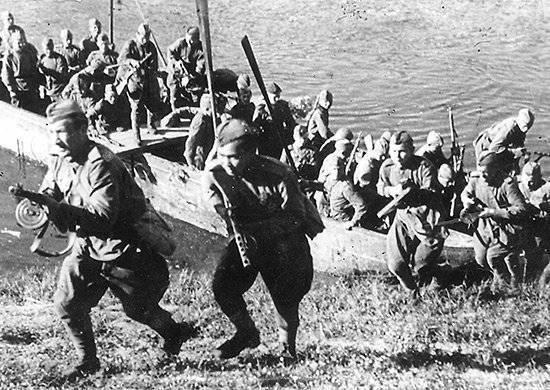
The 3 division of the Byelorussian Front forces the Luches River. June 1944 of the year
Vitebsk-Orsha operation
1 Baltic Front. In the course of reconnaissance in 22 on June, the advanced battalions of the 22 Guards Rifle Corps under the command of Major General Ruchkin from the 6 Guards Army (6 GA) broke through the enemy’s tactical defense, advanced on 4-6 km. There was a threat to the flank and rear of the German 9 Army Corps. The German command was forced to begin the transfer of part of the tactical reserves of the 9 corps to the area east of Obol. As a result, the Germans were deprived of reserves on the first day, which contributed to the 6-th Guards Army and the 43-th Army. The advanced battalions of the 23 Guards Rifle Corps 6 GA and the 1 Rifle Corps 43 And also achieved some success, wedging into the enemy defenses.
The success of June 22 led to significant adjustments to the artillery attack plan. So, in 6 GA, they reduced the time of artillery preparation and reduced the amount of artillery involved by up to 50%. On the morning of June 23, the strike group of the 1st Baltic Front — the 6th Guards Army under the command of Chistyakov and the 43rd Beloborodov Army — went on the offensive. Infantry supported by immediate support tanks aviation and artillery, broke through the enemy’s front on a stretch of 30 km.
Soviet troops began to move rapidly in the western direction. The Germans tried to keep the Soviet offensive by artillery fire and infantry counterattacks by forces from the company to the battalion, supported by groups of tanks on 3-8 machines. However, the Soviet troops continued the offensive. The 1 th rifle corps 43 A, with the support of the 6 units, the GA bypassed Shumilino’s strong resistance node from the flanks and rear and, after a brief but persistent battle, captured the village. The garrison of the stronghold was partly destroyed, partly surrendered.
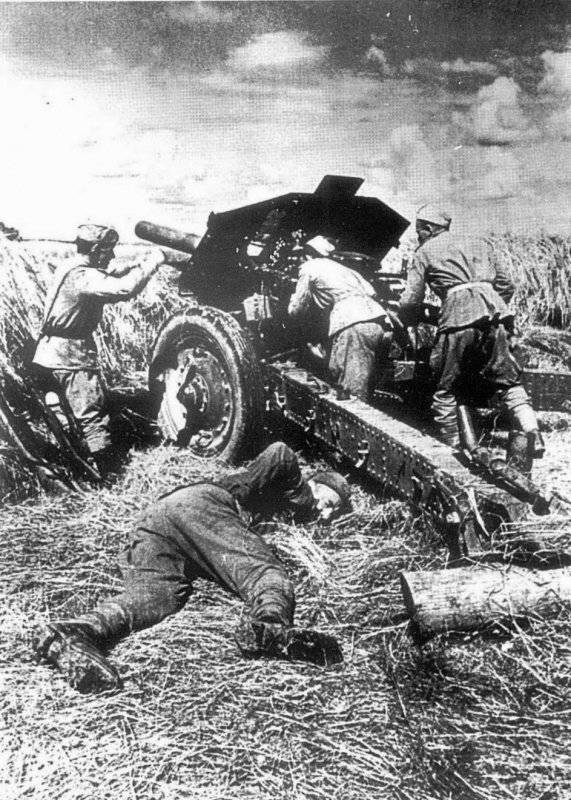
Calculation of the Soviet 122-mm howitzer M-30 in battle against German tanks. 3 Belarusian Front
On the first day of the offensive, the Soviet command planned to bring Butkov's 1 tank corps into battle. He had to advance in the general direction of Beshenkovichi. The hull began to advance in 10 hours (it was located in 14-18 km from the front edge), but the rain significantly worsened the traffic on the roads, and outside of them on the marshland, the movement of tanks was almost impossible. As a result, until the dark tankers could not join the battle. By this time, infantry with support tanks was fighting in the area of inter-aerial defile west and south-west of Shumilin. Due to the considerable delay and the presence of an interscapable defile ahead of the difficult terrain, the Baghramyan commander forbade the commissioning of a tank corps into battle, until the infantry overcomes the interfield defile.
The 23 Guards and 1 Rifle Corps advanced 16 km in a day. On the right flag of 6 HA, the 22 th Guards Corps, overcoming the stubborn resistance of the enemy’s tactical reserves, advanced by 2-7 km. On the same day, at the junction of two Guards Corps, some of the forces of the 103-X rifle corps 6 GA were brought into battle. The 2 Guards Rifle Corps was focused for an offensive.
Cloudiness and variable rain somewhat limited the activities of Soviet aviation, but it carried out 746 sorties (of which 435 assault aircraft). The German Air Force that day was limited to intelligence.
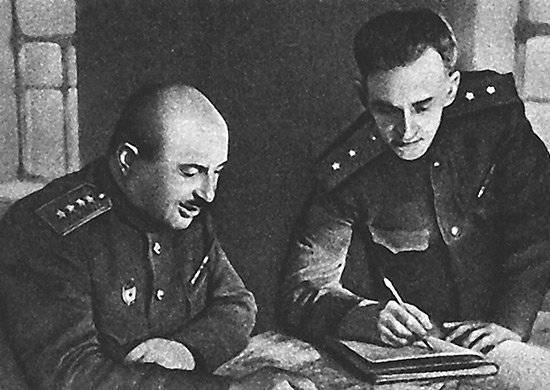
Commander of the 1 Baltic Front, Army General I.Kh. Bagramyan and the Chief of Staff of the Front, Lieutenant-General V.V. Kurasov in the period of the Belarusian operation
Thus, already on the first day of the attack of the shock group of the 1 of the Baltic Front, major successes were achieved. The front of the enemy was broken. The German 9 Army Corps was defeated, its parts, throwing equipment (6 tanks, 66 guns and other weapon and property), hastily retreated to the western and southern shores of the Western Dvina. The German command tried to create a stable defense in the Obol area and on the Western Dvina from the remnants of the corps and the transferred reserves, not allowing the gap to expand. The Soviet command, in order to maintain the pace of the offensive and prevent the enemy from gaining a foothold in the new frontiers, formed advanced mobile units, reinforced by tanks and artillery.
On June 24, the Soviet armies continued their advance, extending the gap to 90 km along the front and 25-30 km in depth. The Germans fiercely resisted - the Soviet troops repulsed 27 counterattacks. By the end of the day 6 GA went to the Western Dvina. The forward detachments forced the river along the river and captured small bridgeheads. The 43 Army, continuing to advance in a southwesterly direction, also advanced to the Western Dvina. The 1 Rifle Corps, under Vasiliev’s command, immediately ran into bridgeheads on the south bank of the river. On the left flank of 43 A part of the 92 Infantry Corps broke through the German defenses and reached the distant approaches of Vitebsk (8 km north of the city). On the right flank of the front, the offensive of the 4 th Shock Army of Malyshev did not bring success. The Germans put up stubborn resistance, and parts of the 4 shock army could not break through the enemy defenses.
The 1 tank corps began to move toward the Western Dvina. However, the few roads after the rains became impassable, almost all the bridges were destroyed by the Germans, they had to be restored. In addition, the roads were filled with second echelons, artillery, pontoons and carts of the advancing armies. Formed numerous traffic jams. Only after it was possible to organize the movement, the tanks, artillery and pontoons were let forward. The tank corps reached the Zapadnaya Dvina only at the end of the day and began preparations for crossing the arm. The aircraft of the 3 Air Force on that day made 1127 sorties (weather conditions improved).
By the end of the second day of the offensive, part 43 A of the 1 of the Baltic Front and 39 A of the 3 of the Belarusian Front went to the rear of the Vitebsk enemy group. The German command, trying to prevent a catastrophe that threatened the Vitebsk group and did not allow the Red Army to force the Western Dvina, hastily hurried reserves and troops from other directions. Two infantry divisions began to be moved from the Idritsky direction to the Polotsk area; two guard divisions, as well as various engineer, construction, guard, penal and other units, were advanced to the line of the Western Dvina. From the area of Pskov, the 212 Infantry Division began to be deployed.
Forcing the Western Dvina. Parts of the 6 GA and 43 A, without waiting for the approach of pontoon connections, immediately began to force the river on various watercrafts. The regimental, divisional artillery and part of the anti-tank artillery regiments and light cannon artillery brigades were transported on rafts shot down by the gunners themselves. This artillery played a large role in retaining and expanding bridgeheads.
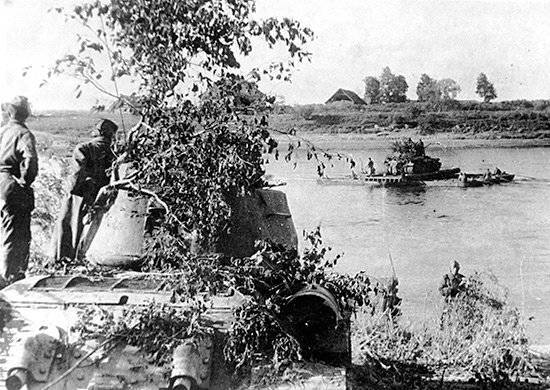
Crossing tanks across the Western Dvina. 1 Baltic Front
The German command, trying to stop the Soviet offensive at any cost, threw hastily assembled units into battle. Soviet troops stationed on bridgeheads were subjected to numerous violent counterattacks. However, the German attacks could not stop the advance of the Soviet troops. The whole day of June 25 continued crossing of the Soviet parts. So, forced the river and expanded the previously occupied bridgehead 23-th Guards Rifle Corps. By the end of the day, the sappers put in pontoon ferries, which greatly accelerated the transfer of artillery and tanks. Parts of 6 GA and 43 And by the end of the day, the city of Beshenkovichi was liberated. The 43 A formations, together with the troops of the 39 Army, completed the encirclement of the Vitebsk enemy group. On the same day, a ferry terminal was built for the transfer of a tank hull. It should be noted that the shock force of this body could not be used in this operation.
June 26 troops of the front strike group marched with 10-20 km. The German command of the remnants of the broken parts and the introduction of new divisions (290-th infantry and 221-th guard) tried to stop the Soviet offensive. During the day, Soviet troops repulsed up to 30 counterattacks, each with forces from the battalion to the infantry regiment with the support of 10-12 tanks. 43-I army part of their forces participated in the elimination of the Vitebsk group. The Luftwaffe, like the previous days, did not show activity. Thus, the 25-26 of June the Baghramian front solved the difficult task of forcing such a large water barrier as the Western Dvina. Less significant water barriers were overcome - the Ulla and Svechanka rivers. The bridgehead was deepened to 18 km.
27-28 June, the troops of the 1 of the Baltic Front developed an offensive in a westerly direction. The 4 rifle corps were included in the 100 th shock army, and the Malyshev army regrouped for the subsequent attack on Polotsk. 22-th Guards Rifle Corps 6 GA took a strong stronghold of the enemy Obolon. The troops of the 43 Army, assisted by the forces of the 3 Belorussian Front, stormed an important stronghold and highway junction, Lepel. The 1 tank corps, after crossing the Ulla River, together with the 2 units of the 6 Guards Corps, GA took the enemy stronghold Kamen.
As a result, for the six days of the offensive, the troops of the 1 of the Baltic Front successfully solved the task set by the Stavka. The strike force of the front broke through the enemy defenses, together with the troops of the 3 of the Belorussian Front destroyed the Vitebsk grouping, forced the Western Dvina, Svechanka, Ulla, and advanced the left wing to 80 km, occupied large Wehrmacht strong points - Beshenkovichi and Lepel. During this time, Soviet troops destroyed more than 25 thousand enemy soldiers and officers, and a lot of military equipment, including 51 aircraft, 322 guns. More than 5 thousand people were captured, 474 guns, more than 1400 machines and other weapons and equipment became Soviet trophies.
The onset of the 3 of the Byelorussian Front
On the afternoon of June 22, the forward battalions of the first-echelon divisions of Krylov's 5 Army, supported by artillery, launched an offensive and with a powerful, sudden blow broke into the enemy's first trench and captured it. Developing the first success, the advance units advanced 2-4 km. At the same time, in the direction of the main attack, the Soviet soldiers captured not only the first trench, but the second and third. The Germans counterattacked, trying to restore the situation, but their blows reflected. In this direction, Soviet troops defeated two regiments of the 299 Infantry Division of the 6 Army Corps and the penal battalion.
At the same time, the forward battalions of the 11 Guards Army of Galitsky attacked the German positions. They were advancing along the Minsk highway. The advanced units of the army broke into the first trench. However, they met strong resistance and could not continue to advance. Here the German troops relied on well-fortified positions. The advanced battalions of the 31 Army of Glagolev were not successful. In the direction of Orsha, the German 78-I assault division of the 27 Army Corps kept the defense, it was well equipped and reinforced with X-gun assault weapons around 50.
The reconnaissance in force showed that the Germans had the weakest defense in the Bogushevsky direction. Five 5 A battalions penetrated deep into the enemy defenses and captured several small bridgeheads on the Sukhodrovka River. At night, the 5 A engineering units built three 60-ton bridges across the river to cross tanks and artillery, and three light bridges for motor vehicles. In addition, the German command already on the first day of the battle used in the offensive zone of the 5 And all divisional reserves and reserves of the 6 corps, part of the 14 infantry division. As a result, the Germans did not have the strength to parry the strike of the main forces of the 5 of the Soviet army.
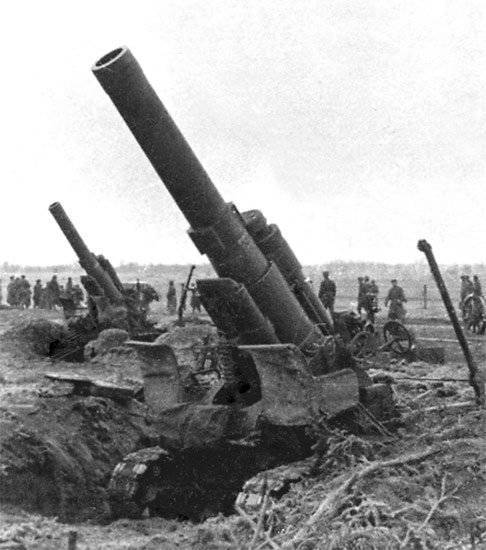
Battery heavy howitzers B-4. 3 Belarusian Front
June 23 on the positions of the enemy was dealt a powerful artillery strike. The first 5 minutes - fire raid of all artillery, 105 minutes - the period of destruction of German defensive structures with aimed fire, 20 minutes - destruction of fortifications by direct fire, and 40 minutes - suppression of the front edge and the nearest depth. In the 5 A band, changes were made to the artillery barrage: artillery fire was shifted to the depth of the enemy defenses.
For 15 minutes before the start of the storming of the German positions, the Soviet air force launched a bombing attack on the German troops. German fighters groups of 4-6 machines tried to prevent the Soviet attacks, but without much success. 1-I Air Army kept air supremacy. In just one day, Soviet aircraft made 1769 sorties, conducted 28 air battles and shot down 15 enemy planes.
In 9 hours, the Soviet infantry, with the support of tanks, launched an offensive on all fronts. 39-I army Lyudnikova broke through the front of the enemy for 6 km and crossed the river Luchesa. At the point of impact was the 5-th Guards Rifle Corps. While advancing westward, the guard corps advanced 12-13 km and intercepted the Vitebsk-Orsha railroad. During the battle, the army defeated the 197 th Infantry Division of the 6 Army Corps. An attempt by the Germans to stop the Soviet offensive with the help of part of the forces of the 95 Infantry Division failed. German troops were driven back to the west.
Krylov's 5 Army delivered the main blow with its right flank. Here parts of the 72 and 65 rifle corps attacked. 5 A connections have expanded the breakthrough to 35 km and advanced to depth to 10 km. The army forced Luchesa and cut the railway Vitebsk - Orsha. The opposing 5 A 299 Infantry Division of the 6 Corps was defeated.
11-I Galitsky Guards Army also broke into the enemy defenses, moving to a depth of 2 to 8 km. On the left flank, in the Minsk motorway, the Soviet troops met the powerful defenses of the enemy. Therefore, the command of the army, with the permission of the com-front, decided to transfer the main attack from the left flank to the right, to the strip of the 16 rifle corps, where there was a success.
31-I army Glagolev penetrated into the defense of the enemy on 3 km and fought hard with the German troops. German infantry, supported by tanks, constantly counterattacked. In this direction, the German command advanced from the reserve to two regiments of infantry reinforced with tanks and artillery.
As a result, the right flank of the front achieved the greatest success. Parts of the 39 and 5 armies broke through the German defenses 10-13 km in depth and expanded the breakthrough to 30 km. The armies, which were advancing in the center and on the left flank, ran into more serious enemy resistance. In addition, the most advanced enemy defenses were located here. They wedged into the enemy's defenses, but could not break through.
On June 24, units of the 39 Army entered the Ostrovno area. Soviet troops intercepted the Wehrmacht’s retreat from Vitebsk to the south-west. At the same time, parts of the 84 Infantry Corps reached the eastern edge of the city. The Germans offered stubborn resistance. The 5 Army, overcoming the resistance of defeated divisions and arrived German reserves, advanced by 10-14 km. In the 21 hour, after a powerful bombing and assault strike that was struck by 270 bombers and attack aircraft, Soviet soldiers with a swift strike from the north broke through the German defenses and stormed the enemy's stronghold. At the same time 24 guns were captured. In connection with the success of 5 A, Oslikovsky's horse-mechanized group was introduced into the breakthrough of its offensive.
11-I Guards Army, using the success achieved by the right flank, captured the district center Babinovichi and defeated several enemy regiments in his area. By the end of the day, the troops of the 11 Army expanded their breakthrough to 30 km and advanced to the depth of 14 km. 31-I army, beating violent counterattacks of the enemy, advanced slightly.
June 25 Chernyakhovsky army continued to develop the offensive. The left flank of 39 A reached the southern coast of the Zapadnaya Dvina in the area Dorogorukovo, Gnezdilovichi Here, the troops of the 3 of the Byelorussian Front united with the forces of 43 of the army of the 1 of the Baltic Front. As a result, the encirclement ring around the Vitebsk grouping of the enemy was closed. In this regard, Tippelskirch noted that three divisions were cut off by the enemy and soon destroyed. In fact, the 53 Army Corps of F. Golwitzer — 206-I and 246-I infantry, 6-I airfield division and 4-I airfield division, and 197-I infantry division of 6-corps were surrounded in Vitebsk region. The commander of the 3 Tank Army, Reinhardt, proposed to withdraw the troops, but Hitler initially forbade the withdrawal of the corps, and when permission was obtained, it was too late.
At the same time, the center 39 A decisive attack seized the eastern part and the center of Vitebsk. The surrounded German units launched a counter-attack against the 18 Guards Rifle Corps before 5, desperately trying to break through to the west and south-west, but all enemy attacks were repelled.
The horse-mechanized group of Oslikovsky rapidly seized the city of Senno. The forward detachments of KMG cut the Lepel-Orsha railway. The troops of the 5 Army, developing the success of KMG, advanced by 20 km, destroying isolated enemy units along the way. Army units freed more than 100 settlements. In addition, given the large-scale success in the offensive zone of the 5 Army, where Soviet troops broke through all German defensive lines and escaped into operational space, at the direction of the Stavka Vasilevsky representative in the Bogushevsky direction, they decided to throw the 5 Guards Tank Army under the command of the Rotmistra .
11-I GA successfully attacked and broke through two fortified lines of the enemy. June 25 in the offensive 11 GA line led to the breakthrough of the 2 th Guards Tatsinsky tank corps under the command of Burdeynoi. He received the task of intercepting German communications: the Minsk road north-west of Orsha and the Orsha-Lepel railway. 31-I army on the right flank broke through the German defense on the Dnieper.
Thus, during the three offensives, the troops of the 3 of the Byelorussian Front completely broke through the German defenses. Soviet troops advanced depth from 30 to 50 km and at the front in 100 km. The Vitebsk and Orsha groups were divided, five enemy divisions surrounded the Vitebsk area. Seven German divisions were defeated or suffered heavy losses. All this time, Soviet aviation firmly held air supremacy, destroying the enemy's 52 aircraft and making more than 2500 thousand sorties just to attack or bomb the enemy forces.
The German command, having lost the main defensive line and suffered a defeat in the Vitebsk and Bogushevsky areas, redeployed the rear of the 3 tank and 4 army to the line of the Berezina river. At the same time, the Germans tried to delay the advance of the Soviet troops at the intermediate lines. The German command began to enter into battle operational reserves. The Germans continued to render especially bitter resistance in the Orsha direction. Trying to keep the Minsk road, the German command transferred the 260 th infantry division from Kopys district and the 286 th guard division from Tolochin district to this area.
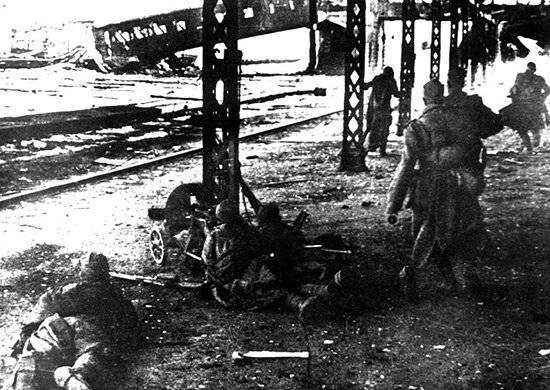
Fight near the station. Vitebsk
Liquidation of the Vitebsk group
Already 25 June Vitebsk group was divided into two parts. On the night of June 26, units of the 39 and 43 army completely liberated Vitebsk. During June 26, the ringed group attempted to break out of the ring environment. The Germans made up to 22 counterattacks with forces from one to two regiments supported by tanks, assault guns and artillery. As a result of the fierce battles, part of the Vitebsk group with great losses broke into the woods in the area of the Moshno lake. However, the narrow corridor was soon closed. On the Comfronte, Chernyakhovsky ordered the three divisions of the 5 Army to be turned, the German group that had broken through was approximately 5. Thousands of soldiers were again surrounded around Moshno Lake.
In the afternoon, the 26 part of the 39 and 43 armies continued to be compressed, surrounded by enemy groups. At the same time, the Soviet Air Force delivered powerful bombing and assault strikes on them. On the morning of June 27, the Soviet troops launched a decisive offensive and broke the resistance of the enemy. Most of the Germans were destroyed. The commander of the 53 Army Corps Golwitzer, his chief of staff, Colonel Shimidt, and a number of other senior officers surrendered. Divisional commanders were among those who surrendered: Müller-Bullov (246-I Infantry Division), Hitter (206-I Infantry Division).
One German group - the remnants of the 4 th airfield division of General R. Pistorius and other units (about 8 thousand people in total), was able to break through in the direction of Beshenkovichi. However, she ran into the forces of the 1 of the Baltic Front and was destroyed in the Yakubov region. Specially allocated detachments of the Soviet divisions continued until 28 June to pursue and destroy small enemy groups. As a result, the Germans lost 20 thousand people killed and 10 thousand prisoners. The entire Vitebsk grouping of the enemy was destroyed. So, according to V. Haupt, from the 53 th army corps only two hundred people broke through to the German units, and the 6 corps was crushed and suffered heavy losses.
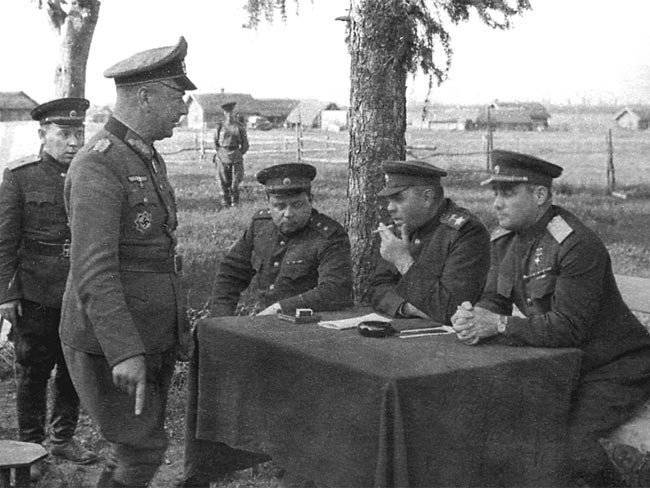
V. E. Makarov, A. M. Vasilevsky and I. D. Chernyakhovsky, a member of the Military Council of the 3 Belorussian Front, interrogated the commander of the 206 Infantry Division A. Hitter
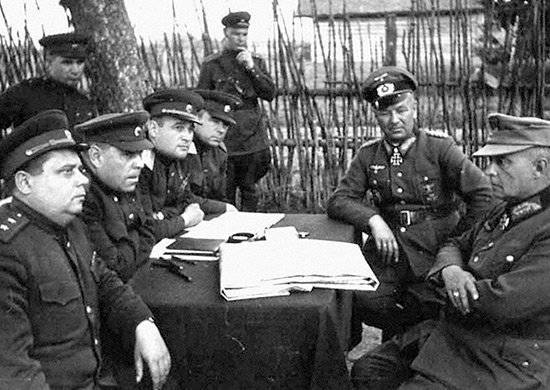
The representative of the Headquarters of the Supreme Command Marshal of the Soviet Union A.M. Vasilevsky and commander of the troops of the 3 of the Byelorussian Front, Colonel-General I. D. Chernyakhovsky is being questioned by the commander of the 53 Army Corps, General Infantry F. Gollwitzer, and the Commander of the 206 Infantry Division, Lieutenant General A. Hitter
Defeat of the Orsha group
The cavalry-mechanized group continued to develop the offensive in the western and south-western directions. Oslikovsky's cavalrymen freed Oboltsy and Smolyany from the Nazis, creating a threat from the northern direction for the Orsha group of the Wehrmacht. Rotmistrov's army freed Tolochin. As a result, the main communications of the German troops in the Orsha region were cut. The Germans tried to repel Tolochin with strong counterattacks, but did not succeed.
At the same time, the 2 Guards Tank Corps of Burdeinoy intercepted the Minsk road in 15 km north-west of Orsha and continued moving southward. 11-I GA 26 June reached the north-western outskirts of Orsha. 31 A took a strong stronghold of the enemy Dubrovno. Thus, the Soviet troops created a threat to the northern flank and rear of the Orsha group. German counterattacks were not successful. It was necessary to withdraw the troops so that they would not suffer the fate of the Vitebsk group.
On the morning of June 27, 31 A broke through the outer belt of Orsha’s defense and broke into the city. In the liberation of the city took part and the troops 11 GA. Soon the city was liberated from the enemy. On the same day, the tankers of Rotmistrov, developing an offensive along the Minsk road, liberated Beaver, Krupki and reached the Borisov area. The horse-mechanized group of Oslikovsky moved to the area south of the Holopenichs. 28 June the front troops marched from 22 to 38 km. KMG Oslikovsky contributed to the forces of the 1 Baltic Front in the liberation of Lepel and went to Berezina.
The defeated troops of the German 3-yankovoy and 4-th armies retreated with their left flank and center to the Berezina. At the same time, on the right wing they continued to put up stubborn resistance, trying to keep Borisov in check and cover the withdrawal of the Mogilev group, which defended itself before the 2 Belorussian Front. Thus, parts of the tank army of Rotmistrov collided with connections of the German 5 tank division, which was transferred to the Borisov direction.
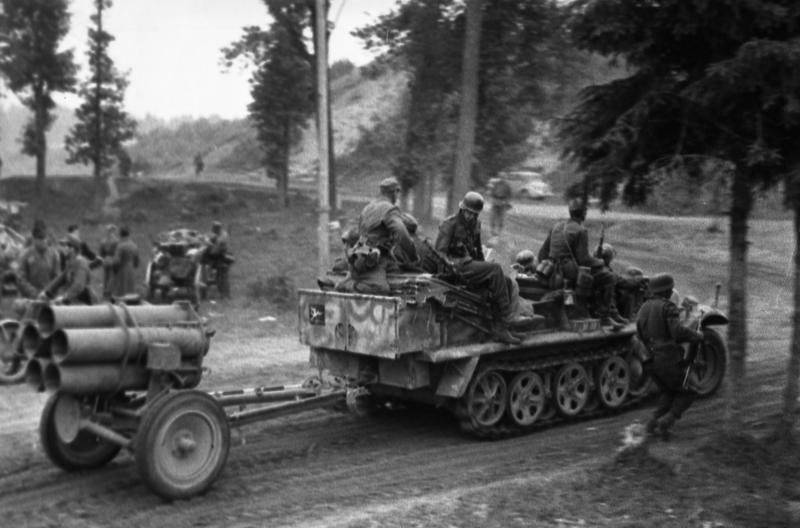
Germans retreat from Orsha
Results
In the five days of the offensive, the troops of the 1 Baltic and 3 Belorussian fronts fully completed their tasks. The northern flank of Army Group Center was destroyed, and thus the Red Army took the first step towards the destruction of the entire Minsk group.
1-th Baltic front under the leadership of Bagramyan broke through the enemy defenses, forced the Western Dvina, freed Beshenkovichi and Lepel, promoted the liberation of Vitebsk and the destruction of the Vitebsk enemy group.
The troops of 3 of the Byelorussian Front, commanded by Chernyakhovsky, broke through the enemy defenses, destroyed the Vitebsk enemy group, and defeated the Orsha group. Orsha, Vitebsk and more than 1600 settlements were liberated. Soviet troops advanced 115 km in depth, creating a breakthrough in 150 km along the front.
The German 53 Army Corps was destroyed or captured, the 6 and 9 Army Corps suffered heavy losses in manpower and equipment. The Germans lost only killed more than 40 thousand people, captured more than 18 thousand soldiers and officers. 126 tanks and assault guns were destroyed, more than 1 thousand guns and mortars, etc. Soviet trophies were about 70 tanks and self-propelled guns, more than 1,1 thousand guns and mortars, more than 3 thousand cars, 32 locomotive, more 1,5 thousand. cars, 255 depots with weapons, ammunition, supplies, equipment, etc. Soviet aircraft destroyed in air battles and on the ground over 70 German aircraft.
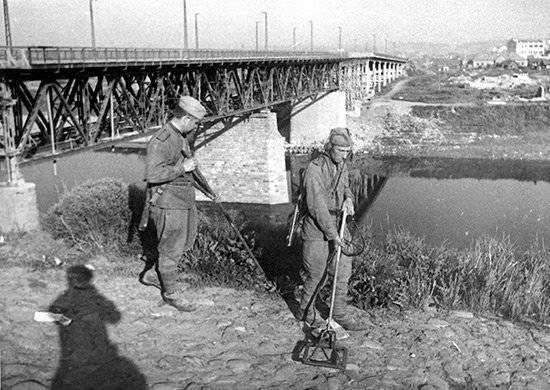
Sappers cleared Vitebsk
- Alexander Samsonov
- Fifth Stalinist strike: operation "Bagration"
Fifth Stalinist strike. Part of 2. Vitebsk-Orsha offensive operation
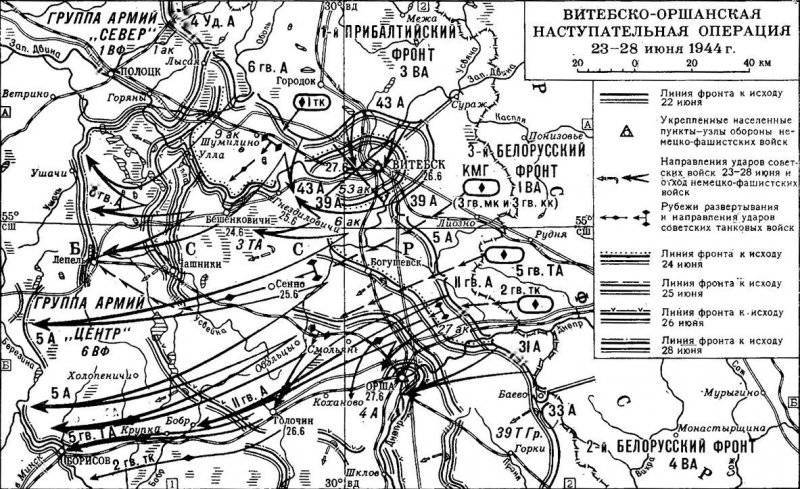
Information